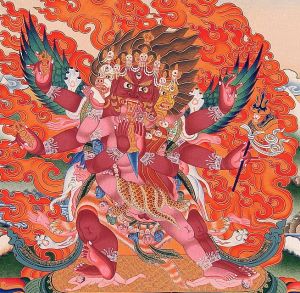Vajrakilaya (Dorje Phurpa in Tibetan) is a wrathful deity of Tibetan Buddhism who transmutes and transcends obstacles and obscurations.
Representation
A common manifestation of Vajrakilla has three heads, six arms, and four legs. Vajrakilaya's three right hands except for the right front one held vajras with five and nine prongs. The right front one makes a mudra as granting boons with open palm. Vajrakilaya's three left hands hold a flaming triple wishfulfilling jewel or triratna, a trident and the kilaya. Vajrakilaya's back is covered by the freshly flayed skin of the elephant representing 'ignorance' (Sanskrit: avidya; Wylie: marigpa), with the legs tied in front. A human skin is tied diagonally across his chest with the hands lying flat on Vajrakilaya's stomach and solar plexus representing the flailed ego that has released its powerful grip obscuring the 'qualities' of the Sadhaka.
Qualities are represented iconographically by the 'vortex' (Sanrkit: chakra; Wylie: Khorlo) of the Manipura (Sanskrit: Ma?ipura). A rope ripples over his body with severed heads hanging by their hair representing the Akshamala or 'garland of bija' (Sanskrit: Varnamala). A knee length loin cloth winds around his belly belted with a tiger skin complete with tail, claws and head. This deity wears manifold naga adornments and jewellery: naga earrings, naga bracelets, naga anklets and a naga cord over his chest, sometimes referred to as a naga gurdle and a naga hairpiece or hair ornament. Vajrakilaya's faces are round and small compared to the tall body. Despite the large fangs and bulging eyes and his wrathful appearance, Vajrakilaya is perceived as having a benevolent demeanor.
Powers
The awesome and wrathful manifestation of this empty yet apparent deity assists practitioners in clearing the obstructions to realization. He is embodied in the kila as a means of destroying (in the sense of finalize and then freeing) violence, hatred, and aggression by tying them to the blade of the kila and then transmuting them with its tip.
Practices
Ritual meditations on the tantric deity, Vajrakīlaya, constitute one of the major and central traditions of Vajrayāna practice. The generation of Vajrakīlaya comes from the Mahāyoga ("Great Yoga") teachings for transforming all experiences into an enlightened expression, and the conduct is in accordance with Mahāyoga.
Vajrakīlaya is meditated on as the natural qualities of the nature of mind's illusory display, in accordance with the Anuyoga path. The View in Vajrakīlaya practice is the Atiyoga realisation, perfected as the unborn, unceasing, and unfabricated fruition.
Vajrakilaya is also understood as the embodiment of activities of the Buddha mind. Sometimes Vajrakilaya is perceived as the wrathful vajrayana form of Vajrapani, according to Dilgo Khyentse Rinpoche.
Many great masters both in India and Tibet, but especially in Tibet, have practiced Vajrakilaya (especially in the Nyingma lineage, and among the Kagyu and also within the Sakyapas). The Sakyapa's main deity, besides Hevajra is Vajrakumara or Vajrakilaya.
See also
Vajrakīlaya is a wrathful form of Vajrasattva, the pure vajra nature of Enlightenment.

